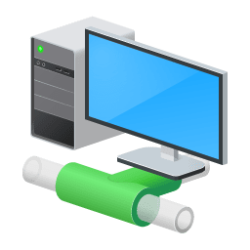This tutorial will show you how to export (backup) one or more Hyper-V virtual machines at once in Windows 10 and Windows 11.
Hyper-V enables running virtualized computer systems on top of a physical host. These virtualized systems can be used and managed just as if they were physical computer systems, however they exist in virtualized and isolated environment. Special software called a hypervisor manages access between the virtual systems and the physical hardware resources. Virtualization enables quick deployment of computer systems, a way to quickly restore systems to a previously known good state, and the ability to migrate systems between physical hosts.
You can export a Hyper-V virtual machine to back it up, and import (restore) as needed. An export gathers all required files into one unit--virtual hard disk files, virtual machine configuration files, and any checkpoint files. You can do this on a virtual machine that is in either a started or stopped state.
Reference:

Export and import virtual machines
This article shows you how to export and import virtual machines using Hyper-V Manager or Windows PowerShell.
learn.microsoft.com
You must be signed in as an administrator to export a Hyper-V virtual machine.
Contents
- Option One: Export Hyper-V Virtual Machine(s) in Hyper-V Manager
- Option Two: Export Specific Hyper-V Virtual Machine in PowerShell
- Option Three: Export All Hyper-V Virtual Machines in PowerShell
1 Open Hyper-V Manager (virtmgmt.msc).
2 Select one or more virtual machines (ex: "Windows 11 Home") in the middle pane you want to export. (see screenshot below)
3 Perform one of the following actions below to export the virtual machine(s):
- Click/tap on Export in the right "Actions" pane.
- Click/tap on Action on the menu bar, and click/tap on Export.
- Right click on the selected virtual machine(s) in the middle pane, and click/tap on Export.
4 Perform the following steps to select where to export and export: (see screenshots below)
- Click/tap on Browse.
- Navigate to and select the folder (ex: "D:\VM Backups") where you want to export the virtual machine(s) into.
- Click/tap on Select Folder.
- Click/tap on Export.
5 When exporting has finished, you can close Hyper-V Manager if you like. (see screenshot below)
1 Open Windows Terminal (Admin), and select Windows PowerShell.
2 Copy and paste the command below into Windows Terminal (Admin), and press Enter. (see screenshot below step 3)
Get-VM3 Make note of the virtual machine name (ex: "Windows 11 Home") you want to export. (see screenshot below)
4 Type the command below into Windows Terminal (Admin), and press Enter. (see screenshotd below)
Export-VM -Name "<VM Name>" –Path "<Full path of folder>"Substitute <VM Name> in the command above with the actual virtual machine name (ex: "Windows 11 Home") from step 3 you want to export.
Substitute <Full path of folder> in the command above with the full path of the folder (ex: "D:\VM Backups") you want to export all virtual machines into.
For example: Export-VM -Name "Windows 11 Home" –Path "D:\VM Backups"
5 When exporting has finished, you can close Windows Terminal (Admin) if you like.
1 Open Windows Terminal (Admin), and select Windows PowerShell.
2 Type the command below into Windows Terminal (Admin), and press Enter. (see screenshot below)
Get-VM | Export-VM –Path "<Full path of folder>"Substitute <Full path of folder> in the command above with the full path of the folder (ex: "D:\VM Backups") you want to export all virtual machines into.
For example: Get-VM | Export-VM –Path "D:\VM Backups"
3 When exporting has finished, you can close Windows Terminal (Admin) if you like. (see screenshots below)
You will see a separate exporting percentage status per virtual machine being exported.
That's it,
Shawn Brink
Related Tutorials
- Import Hyper-V Virtual Machine in Windows 11
- Create Checkpoint for Hyper-V Virtual Machine in Windows 11
- Enable or Disable Automatic Checkpoints for Hyper-V Virtual Machine in Windows 11
- Rename Hyper-V Virtual Machine in Windows 11
- Delete Hyper-V Virtual Machine in Windows 11
- Upgrade Configuration Version for Hyper-V Virtual Machine in Windows 11
Last edited:












